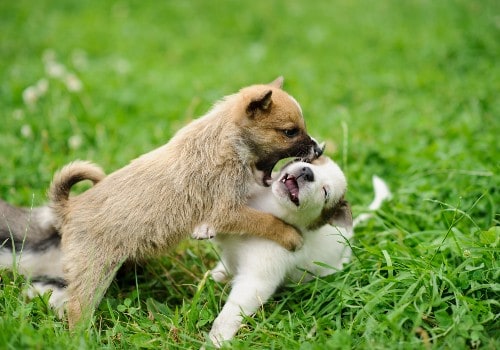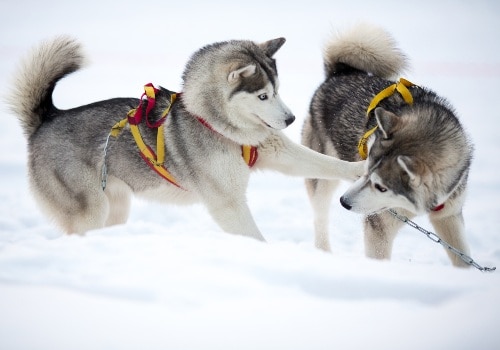When two dogs get along, it’s like magic. The way they play off each other’s energies, complement each other’s personalities and enjoy each other’s company is like nothing else in the world.
But when relations between them go south, there’s nothing joyful about it.
Dog fights aren’t just unpleasant to see and hear. They’re potentially dangerous, with sharp teeth, pointy claws and strong bodies tumbling around amidst a cacophony of growls and snarls.
And if the fight gets too serious, one or both of the dogs could become injured. In the worst cases, the damage is so severe that it results in permanent injury or death.
So what drives dogs to fight with each other — and how can you put a stop to it?
Dog Fight Causes and Solutions
There’s a story behind every dog fight, but it’s not always obvious just what it is. Yet it’s important to know the cause of a dog fight in order to resolve the conflict.
Here are a few of the common reasons for dog fights and tips to help you restore the peace.
Territorial Disputes

Dogs are highly territorial animals. They stake claim to their domains and patrol them with vigor, marking their borders with urine and pheromones and threatening any intruders with bared teeth and unfriendly growls.
And when their warnings aren’t heeded, things can get ugly. In fact, territorial disputes are one of the most common reasons for dog fights.
Whether it’s a block in your neighborhood, a seat on the couch or a favorite peeing spot in your yard, your dog demands that his territory be respected. The same goes for objects that “belong” to your dog, like toys, food and even people.
So when a new dog shows up and attempts to claim some of your dog’s territory for himself, it’s important for you to be alert and ready to mediate a fight.
Stopping Territorial Fighting
Territorial fights between two dogs in the same household can be controlled by making sure each dog has his own special spot. This may mean getting each dog a different bed or moving their food bowls to separate areas.
Other fights, like those that occur when a strange dog wanders into your yard, are harder to control. For these fights, the best approach may be prevention via good training.
Train your dog to obey your commands from an early age, including “leave it” and “go lie down.” At the first sign of conflict, use these commands to get your dog out of the situation and into a place where he can calm down without getting aggressive first.
Overstimulation
Ever seen a play session between two dogs that escalates too far? Maybe one dog accidentally bites instead of mouths, or maybe one body-slams the other a little too hard.
When this happens, playtime can turn into a nightmare. The dogs are already riled up and adrenaline is flowing from the play, so it doesn’t take much at all for that energy to get redirected into aggression.
Most dogs are able to establish play boundaries without the situation devolving into a bloodbath. But when play gets too rough and the dogs get overstimulated, they may not be able to stop themselves from fighting.
Stopping Overstimulated Fighting

The risk of overstimulation is why it’s important to supervise play sessions, especially with unfamiliar dogs.
Keep an eye on the dogs’ body language during play: a happy dog will have a relaxed facial expression and playful vocalizations. If you notice pinned-back ears, bared teeth, deep snarls or a stiff posture, end the play session before emotions run any hotter.
Incompatibility
Sometimes we meet someone we just don’t like. They may not have wronged us in any way, but we’re just not compatible with each other’s personalities, and we try to keep our interactions to a minimum.
This happens with dogs, too. Some dogs just don’t like each other for whatever reason, and if they’re forced to be around each other, they may get on each other’s nerves until a fight breaks out.
Stopping Incompatibility-Related Fighting
The obvious solution is to keep dogs that don’t like each other apart. Minimizing the opportunities for interaction is the best way to prevent fights between two disagreeing dogs.
But when that’s not possible, keeping the dogs distracted when they’re around each other is the next-best option. When the other dog is nearby, surprise your dog with his favorite toy or a few easy commands and treats may keep emotions from boiling over.
Breaking Up a Dog Fight
If two dogs are already fighting and you need to break it up, there are a few precautions to take to ensure that neither you or the dogs get hurt.
Never physically intervene in a dog fight unless it’s absolutely necessary. You’re likely to get bitten amidst all the turmoil.
Instead, try making loud noises or spraying the dogs with water to startle them and stop the fighting long enough to safely get them away from each other. If possible, have another person help by serving as the distractor while you move the dogs, or vice versa.
You can also throw a heavy blanket over the dogs to confuse them and get them off each other. Another strategy is to wedge a long umbrella between the dogs and then open it to force them away from one another.
